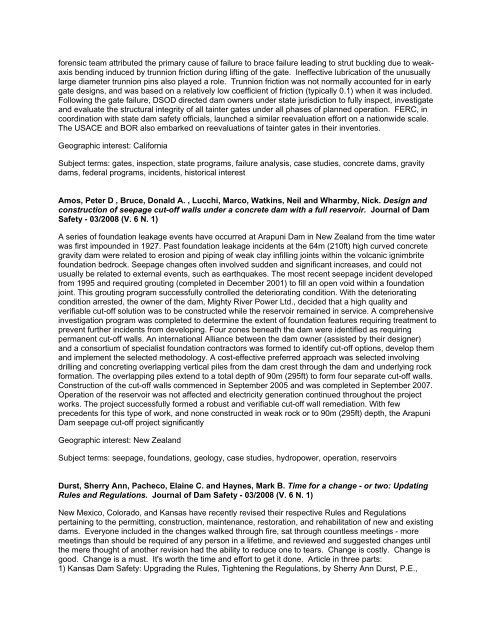Annotated List of Articles Published in the Journal of Dam Safety ...
Annotated List of Articles Published in the Journal of Dam Safety ...
Annotated List of Articles Published in the Journal of Dam Safety ...
- No tags were found...
Create successful ePaper yourself
Turn your PDF publications into a flip-book with our unique Google optimized e-Paper software.
forensic team attributed <strong>the</strong> primary cause <strong>of</strong> failure to brace failure lead<strong>in</strong>g to strut buckl<strong>in</strong>g due to weakaxisbend<strong>in</strong>g <strong>in</strong>duced by trunnion friction dur<strong>in</strong>g lift<strong>in</strong>g <strong>of</strong> <strong>the</strong> gate. Ineffective lubrication <strong>of</strong> <strong>the</strong> unusuallylarge diameter trunnion p<strong>in</strong>s also played a role. Trunnion friction was not normally accounted for <strong>in</strong> earlygate designs, and was based on a relatively low coefficient <strong>of</strong> friction (typically 0.1) when it was <strong>in</strong>cluded.Follow<strong>in</strong>g <strong>the</strong> gate failure, DSOD directed dam owners under state jurisdiction to fully <strong>in</strong>spect, <strong>in</strong>vestigateand evaluate <strong>the</strong> structural <strong>in</strong>tegrity <strong>of</strong> all ta<strong>in</strong>ter gates under all phases <strong>of</strong> planned operation. FERC, <strong>in</strong>coord<strong>in</strong>ation with state dam safety <strong>of</strong>ficials, launched a similar reevaluation effort on a nationwide scale.The USACE and BOR also embarked on reevaluations <strong>of</strong> ta<strong>in</strong>ter gates <strong>in</strong> <strong>the</strong>ir <strong>in</strong>ventories.Geographic <strong>in</strong>terest: CaliforniaSubject terms: gates, <strong>in</strong>spection, state programs, failure analysis, case studies, concrete dams, gravitydams, federal programs, <strong>in</strong>cidents, historical <strong>in</strong>terestAmos, Peter D , Bruce, Donald A. , Lucchi, Marco, Watk<strong>in</strong>s, Neil and Wharmby, Nick. Design andconstruction <strong>of</strong> seepage cut-<strong>of</strong>f walls under a concrete dam with a full reservoir. <strong>Journal</strong> <strong>of</strong> <strong>Dam</strong><strong>Safety</strong> - 03/2008 (V. 6 N. 1)A series <strong>of</strong> foundation leakage events have occurred at Arapuni <strong>Dam</strong> <strong>in</strong> New Zealand from <strong>the</strong> time waterwas first impounded <strong>in</strong> 1927. Past foundation leakage <strong>in</strong>cidents at <strong>the</strong> 64m (210ft) high curved concretegravity dam were related to erosion and pip<strong>in</strong>g <strong>of</strong> weak clay <strong>in</strong>fill<strong>in</strong>g jo<strong>in</strong>ts with<strong>in</strong> <strong>the</strong> volcanic ignimbritefoundation bedrock. Seepage changes <strong>of</strong>ten <strong>in</strong>volved sudden and significant <strong>in</strong>creases, and could notusually be related to external events, such as earthquakes. The most recent seepage <strong>in</strong>cident developedfrom 1995 and required grout<strong>in</strong>g (completed <strong>in</strong> December 2001) to fill an open void with<strong>in</strong> a foundationjo<strong>in</strong>t. This grout<strong>in</strong>g program successfully controlled <strong>the</strong> deteriorat<strong>in</strong>g condition. With <strong>the</strong> deteriorat<strong>in</strong>gcondition arrested, <strong>the</strong> owner <strong>of</strong> <strong>the</strong> dam, Mighty River Power Ltd., decided that a high quality andverifiable cut-<strong>of</strong>f solution was to be constructed while <strong>the</strong> reservoir rema<strong>in</strong>ed <strong>in</strong> service. A comprehensive<strong>in</strong>vestigation program was completed to determ<strong>in</strong>e <strong>the</strong> extent <strong>of</strong> foundation features requir<strong>in</strong>g treatment toprevent fur<strong>the</strong>r <strong>in</strong>cidents from develop<strong>in</strong>g. Four zones beneath <strong>the</strong> dam were identified as requir<strong>in</strong>gpermanent cut-<strong>of</strong>f walls. An <strong>in</strong>ternational Alliance between <strong>the</strong> dam owner (assisted by <strong>the</strong>ir designer)and a consortium <strong>of</strong> specialist foundation contractors was formed to identify cut-<strong>of</strong>f options, develop <strong>the</strong>mand implement <strong>the</strong> selected methodology. A cost-effective preferred approach was selected <strong>in</strong>volv<strong>in</strong>gdrill<strong>in</strong>g and concret<strong>in</strong>g overlapp<strong>in</strong>g vertical piles from <strong>the</strong> dam crest through <strong>the</strong> dam and underly<strong>in</strong>g rockformation. The overlapp<strong>in</strong>g piles extend to a total depth <strong>of</strong> 90m (295ft) to form four separate cut-<strong>of</strong>f walls.Construction <strong>of</strong> <strong>the</strong> cut-<strong>of</strong>f walls commenced <strong>in</strong> September 2005 and was completed <strong>in</strong> September 2007.Operation <strong>of</strong> <strong>the</strong> reservoir was not affected and electricity generation cont<strong>in</strong>ued throughout <strong>the</strong> projectworks. The project successfully formed a robust and verifiable cut-<strong>of</strong>f wall remediation. With fewprecedents for this type <strong>of</strong> work, and none constructed <strong>in</strong> weak rock or to 90m (295ft) depth, <strong>the</strong> Arapuni<strong>Dam</strong> seepage cut-<strong>of</strong>f project significantlyGeographic <strong>in</strong>terest: New ZealandSubject terms: seepage, foundations, geology, case studies, hydropower, operation, reservoirsDurst, Sherry Ann, Pacheco, Ela<strong>in</strong>e C. and Haynes, Mark B. Time for a change - or two: Updat<strong>in</strong>gRules and Regulations. <strong>Journal</strong> <strong>of</strong> <strong>Dam</strong> <strong>Safety</strong> - 03/2008 (V. 6 N. 1)New Mexico, Colorado, and Kansas have recently revised <strong>the</strong>ir respective Rules and Regulationsperta<strong>in</strong><strong>in</strong>g to <strong>the</strong> permitt<strong>in</strong>g, construction, ma<strong>in</strong>tenance, restoration, and rehabilitation <strong>of</strong> new and exist<strong>in</strong>gdams. Everyone <strong>in</strong>cluded <strong>in</strong> <strong>the</strong> changes walked through fire, sat through countless meet<strong>in</strong>gs - moremeet<strong>in</strong>gs than should be required <strong>of</strong> any person <strong>in</strong> a lifetime, and reviewed and suggested changes until<strong>the</strong> mere thought <strong>of</strong> ano<strong>the</strong>r revision had <strong>the</strong> ability to reduce one to tears. Change is costly. Change isgood. Change is a must. It's worth <strong>the</strong> time and effort to get it done. Article <strong>in</strong> three parts:1) Kansas <strong>Dam</strong> <strong>Safety</strong>: Upgrad<strong>in</strong>g <strong>the</strong> Rules, Tighten<strong>in</strong>g <strong>the</strong> Regulations, by Sherry Ann Durst, P.E.,
















